|
|
|
Sort Order |
|
|
|
Items / Page
|
|
|
|
|
|
|
| Srl | Item |
| 1 |
ID:
177493
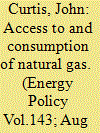

|
|
|
|
|
| Summary/Abstract |
This research examines fuel choice for residential heating, with a particular focus on switching to natural gas from carbon intensive alternatives. In the context of reducing greenhouse gas emissions in the residential sector, fuel switching from coal and oil to natural gas for space heating is assessed as a potential policy option using Ireland as a case study. A range of building attributes and household characteristics are associated with fuel choice for household space heating, including distance to the gas network, which is inversely associated with the probability of gas connection. Distance decay effects are likely attributed to network connection fees, which are proportional to the connection distance. The impact of setting the marginal connection cost associated with distance to zero are simulated to examine emission and expenditure impacts across socio-economic groups. Up to 13% of unconnected properties are likely to respond to such an incentive, yielding a 3.9% reduction in greenhouse gas emissions and a 1.5% reduction in fuel expenditure relative to pre-policy levels of unconnected households within the study. Expenditure and emission impacts differ across socio-economic groups with the largest reductions expected to occur among semi-skilled/unskilled households, which are frequently among the least affluent households.
|
|
|
|
|
|
|
|
|
|
|
|
|
|
|
|
| 2 |
ID:
149898
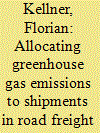

|
|
|
|
|
| Summary/Abstract |
The European Norm EN 16258 was published in 2012 to provide a common methodology for the calculation and declaration of energy consumption and greenhouse gas emissions related to any transport operation. The objective was to offer a pragmatic and scientifically-acceptable approach that allows a wide group of users to prepare standardized, accurate, credible, comparable, and verifiable energy consumption and emission declarations. However, in its current form, EN 16258 contains gaps and ambiguities, and leaves room for interpretation, which makes comparisons of supply chains difficult. This research aims to overcome the shortcomings in the domain of allocating emissions from road freight transport operations to single shipments. Based on a discussion of emission drivers and the results of numerical experiments comparing the allocation vectors created by the EN 16258 allocation rules with those generated by the Shapley value, which is claimed to be the benchmark, ‘distance’ is identified as the single most useful unit for bridging the trade-off between accuracy and simplicity better than the other recommended allocation schemes. Thus, this paper claims that future versions of EN 16258 should only allow the allocation unit ‘distance.’ This will promote the accurateness, simplicity, consistency, transparency, and comparability of emission declarations.
|
|
|
|
|
|
|
|
|
|
|
|
|
|
|
|
| 3 |
ID:
113145


|
|
|
|
|
| Publication |
2012.
|
| Summary/Abstract |
Public opinion about energy can be understood in a unified framework. First, people evaluate key attributes of energy sources, particularly a fuel's cost and environmental harms. Americans, for example, view coal as relatively inexpensive but harmful, natural gas as less harmful but more expensive, and wind as inexpensive and not harmful. Second, people place different weights on the economic and environmental attributes associated with energy production, which helps explain why some fuels are more popular than others. Americans' attitudes toward energy are driven more by beliefs about environmental harms than by perceived economic costs. In addition, attitudes about energy sources are largely unrelated to views about global warming. These findings suggest that a politically palatable way to reduce greenhouse gas emissions is through regulation of traditional pollutants associated with fossil fuels, rather than a wholly new carbon policy.
|
|
|
|
|
|
|
|
|
|
|
|
|
|
|
|
| 4 |
ID:
169747
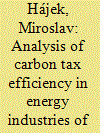

|
|
|
|
|
| Summary/Abstract |
A carbon tax is one of economic policy instruments of environmental protection supposed to contribute to the reduction of greenhouse gas (GHG) emissions. A functional carbon tax aims at incorporating costs for elimination of environmental harm into the pricing decisions. In terms of global climate change, the carbon tax is usually imposed on the production, distribution or consumption of carbon-content fossil fuels. The main aim of the study is to evaluate the carbon tax environmental effectiveness in the energy industries of selected EU countries, namely Sweden, Finland, Denmark, Ireland and Slovenia. To achieve the principal research objective, the multiple panel regression method for the selected variables was used, the synergy of other environmental policy tools being taken into account. Control variables employed were emission allowance price, household final consumption expenditure, corporate investments, solid fuel consumption and renewable energy consumption. The analysis results suggest that the carbon tax in the energy industry is environmentally efficient, an increased tax rate allowing to reduce GHG production, which is statistically significantly affected by the consumption of fossil fuels. Based on the estimated partial regression coefficient (−0.01158), raising the carbon tax by one euro per tonne can cut annual per capita emissions by 11.58 kg.
|
|
|
|
|
|
|
|
|
|
|
|
|
|
|
|
| 5 |
ID:
094231


|
|
|
|
|
| Publication |
2010.
|
| Summary/Abstract |
Even as the US debates an economy-wide CO2 cap-and-trade policy the transportation sector remains a significant oil security and climate change concern. Transportation alone consumes the majority of the US's imported oil and produces a third of total US Greenhouse-Gas (GHG) emissions. This study examines different sector-specific policy scenarios for reducing GHG emissions and oil consumption in the US transportation sector under economy-wide CO2 prices. The 2009 version of the Energy Information Administration's (EIA) National Energy Modeling System (NEMS), a general equilibrium model of US energy markets, enables quantitative estimates of the impact of economy-wide CO2 prices and various transportation-specific policy options. We analyze fuel taxes, continued increases in fuel economy standards, and purchase tax credits for new vehicle purchases, as well as the impacts of combining these policies. All policy scenarios modeled fail to meet the Obama administration's goal of reducing GHG emissions 14% below 2005 levels by 2020. Purchase tax credits are expensive and ineffective at reducing emissions, while the largest reductions in GHG emissions result from increasing the cost of driving, thereby damping growth in vehicle miles traveled.
|
|
|
|
|
|
|
|
|
|
|
|
|
|
|
|
| 6 |
ID:
121311


|
|
|
|
|
| Publication |
2013.
|
| Summary/Abstract |
Biogas production processes are often multifunctional systems, which also produce fertilizers from digested sludge. The environmental impacts of such systems are usually determined using life cycle assessment (LCA). There are alternative approaches to conduct the LCA, e.g., allocation of emissions based on a product's and co-product's energy content according to the Renewable Energy Directive (RED), or substitution without allocation according to the ISO 14040 standard. We calculated the climate change impacts of biogas production using these two alternative methods, whilst also considering process modifications of the base case biogas production process. The aim was to find out whether the production system achieves the saving targets for greenhouse gas (GHG) emissions set by the RED. Since the RED enables different interpretations of its calculation rules, we created four case studies representing alternative ways to allocate the emissions to the reject water and solid fractions separated from the sludge. Consequently, our emission estimates for the base case vary between 16.9 and 47.7 g CO2/MJ, while the emission savings range from 42% to 80%. Most of the case studies achieved the most stringent saving target (60%).
|
|
|
|
|
|
|
|
|
|
|
|
|
|
|
|
| 7 |
ID:
171518


|
|
|
|
|
| Summary/Abstract |
California law requires statewide greenhouse gas (GHG) emissions to return to 1990 levels by 2020—a goal achieved in 2016, four years early. We conduct the first independent retrospective analysis of California's greenhouse gas emissions to assess how the state has achieved faster-than-expected emissions reductions. We analyze the extent to which economic activity, climate policies, and market forces drove California's greenhouse gas emissions trends overall and in two key categories: electricity and light-duty vehicles. We also compare historical trends with business-as-usual and policy expectations from the 2008 Climate Change Scoping Plan, California's official strategy for achieving the 2020 emissions limit. Our analysis, based on data through 2017, indicates that reduced economic activity during the 2008–2009 recession and its aftermath has been a major contributor to early achievement of the 2020 emissions limit. Policies and market forces, however, have played a larger role in reducing emissions in recent years—particularly in the electricity sector, which has decarbonized more rapidly than expected. Meanwhile, GHG emissions from light-duty vehicles in recent years were rising, not falling, in contrast to expectations. Our analysis demonstrates how decomposition methods can be used to track climate policy implementation and inform future policy development.
|
|
|
|
|
|
|
|
|
|
|
|
|
|
|
|
| 8 |
ID:
103382


|
|
|
|
|
| Publication |
2011.
|
| Summary/Abstract |
European freight transport emissions and fuel consumption are projected to increase. This study focuses on long distance freight transport (LDFT) and explores possible sustainable futures through quantitative modeling. The evaluation was part of European foresight process between researchers, policy makers and freight companies (FREIGHTVISION). Greenhouse gas (GHG) emissions and energy demand of road, rail and inland waterways were estimated for an EU-27 in 2005. Development was extrapolated to 2050 based on technology and freight performance forecasts. Stakeholders found the forecasted GHG emissions and fossil fuel share unsustainable, so alternative futures were developed with backcasting. The developed emission model was run with random parameter combinations to screen a set of sustainable futures, with an 80% reduction of GHG emissions and fossil fuel share. Freight transport performance was not controlled in the backcasts, but several sustainable futures were found if significant changes in transport efficiency and energy mix are implemented. In spite of agreeing on the importance of reducing emissions, stakeholders had difficulties in choosing a preferred technological future. Simple models were found to be an effective tool for communicating the influence of various measures. Further research is recommended to screen preferable technological roadmaps from the broad range of available futures.
|
|
|
|
|
|
|
|
|
|
|
|
|
|
|
|
| 9 |
ID:
109321


|
|
|
|
|
| Publication |
2011.
|
| Summary/Abstract |
The development of urbanization is accelerating in China, and there are great pressures and opportunities in cities to reduce carbon emissions. An emissions inventory is a basic requirement for analyzing emissions of greenhouse gases (GHGs), their potential reduction and to realize low-carbon development of cities. This study describes a method to establish a GHGs emissions inventory in Chinese cities for 6 emission sources including industrial energy consumption, transportation, household energy consumption, commercial energy consumption, industrial processes and waste. Nanjing city was selected as a representative case to analyze the characteristics of carbon emissions in Chinese cities. The results show that carbon emissions in Nanjing have increased nearly 50% during the last decade. The three largest GHGs contributors were industrial energy consumption, industrial processes and transportation, which contributed 37-44%, 35-40% and 6-10%, respectively, to the total GHGs emissions. Per GDP carbon emissions decreased by 55% from 2002 to 2009, and the per capita and per GDP carbon emissions were comparable or even lower than the world average levels. These results have important policy implications for Chinese cities to control their carbon emissions.
|
|
|
|
|
|
|
|
|
|
|
|
|
|
|
|
| 10 |
ID:
183598
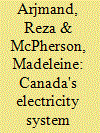

|
|
|
|
|
| Summary/Abstract |
To meet Canada's emissions reduction targets, governments at the federal and provincial levels have developed climate plans and implemented a series of policies and regulations. Canada's latest climate plan, entitled “A Healthy Environment and a Healthy Economy” aims to decarbonize various sectors of the economy including the electricity sector. In this paper, we explore the extent to which implementing announced policies and regulations could drive investment in the electricity sector needed to achieve Canada's climate objectives. To do so, we propose a multi-period, optimization-based capacity expansion model specifically designed for the Canadian context entitled COPPER for the “Canadian Opportunities for Planning and Production of Electricity Resources.” We employ COPPER to analyze Canada's electricity system transition under various carbon management policies. Results show that current and announced policies significantly increase renewable energy capacity, which in turn decrease the electricity system emissions by 40 percent in the mid-term. However, in the long-term, more ambitious actions will be required to achieve the emissions reduction targets. Natural gas-powered generation facilities persist at the proposed carbon tax levels, and thus supplementary regulations or policies will be needed to achieve deep decarbonization.
|
|
|
|
|
|
|
|
|
|
|
|
|
|
|
|
| 11 |
ID:
176761
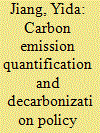

|
|
|
|
|
| Summary/Abstract |
The household sector has been identified as a major driver of the economy and an important contributor to greenhouse gas (GHG) emissions. It is also pointed out by existing studies that influential factors of household emissions range from socioeconomic to geographic aspects. Promoting efficient and feasible decarbonization actions therefore calls for the quantification of the variability in emission patterns and its relationship with contextual factors. In this study, using data on monthly household expenditures at the city level, direct and indirect carbon emissions resulting from household consumption in 51 major Japanese cities in 2011 are calculated. A regression analysis is also conducted to explore the relationship between emissions from the household sector and the socioeconomic, demographic, and climatic characteristics of Japanese cities. Our results indicate seasonality and categorical differences in residential carbon emissions for cities in Japan. We also find per capita income, urban population density, and proportion of the population over 65 years old to be the most influential variables that shape the residential emission landscape of Japanese cities. We thus suggest that seasonality, categories of consumption, and city characteristics be considered as crucial factors in policy making for emission mitigation targeting consumption behavior of urban residents.
|
|
|
|
|
|
|
|
|
|
|
|
|
|
|
|
| 12 |
ID:
094959


|
|
|
|
|
| Publication |
2010.
|
| Summary/Abstract |
Greenhouse gas emissions from international transport contribute to anthropogenic global warming, yet these emissions are not liable under the Kyoto Protocol. International attention is being given to quantifying such emissions. This paper presents the results of research into international cruise ship journeys to and from New Zealand. CO2 emissions from such journeys were calculated using an activity based, or "bottom-up", model. Emissions factors for individual journeys by cruise ships to or from New Zealand in 2007 ranged between 250 and 2200 g of CO2 per passenger-kilometre (g CO2 per p-km), with a weighted mean of 390 g CO2 per p-km. The weighted mean energy use per passenger night for the "hotel" function of these cruise vessels was estimated as 1600 MJ per visitor night, 12 times larger than the value for a land-based hotel. Using a simple price elasticities calculation, international cruise journeys for transport purposes were found to have a greater relative decrease in demand than plane journeys when the impact of carbon pricing was analysed. The potential to decrease the CO2 emissions per p-km was examined, and if passenger accommodation was compacted and some luxury amenities dispensed with values similar to those of economy-class air travel were obtained.
|
|
|
|
|
|
|
|
|
|
|
|
|
|
|
|
| 13 |
ID:
109636
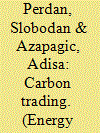

|
|
|
|
|
| Publication |
2011.
|
| Summary/Abstract |
This paper looks at the greenhouse gas (GHG) emissions trading schemes and examines the prospects of carbon trading. The first part of the paper gives an overview of several mandatory GHG trading schemes around the world. The second part focuses on the future trends in carbon trading. It argues that the emergence of new schemes, a gradual enlargement of the current ones, and willingness to link existing and planned schemes seem to point towards geographical, temporal and sectoral expansion of emissions trading. However, such expansion would need to overcome some considerable technical and non-technical obstacles. Linking of the current and emerging trading schemes requires not only considerable technical fixes and harmonisation of different trading systems, but also necessitates clear regulatory and policy signals, continuing political support and a more stable economic environment. Currently, the latter factors are missing. The global economic turmoil and its repercussions for the carbon market, a lack of the international deal on climate change defining the Post-Kyoto commitments, and unfavourable policy shifts in some countries, cast serious doubts on the expansion of emissions trading and indicate that carbon trading enters an uncertain period.
|
|
|
|
|
|
|
|
|
|
|
|
|
|
|
|
| 14 |
ID:
182578


|
|
|
|
|
| Summary/Abstract |
Diets are key determinants of nutrition and health and play a significant role in the environment. In this article, we aim to (i) describe dietary transitions and health in China and the consequent environmental challenges; (ii) identify differences between current Chinese diets and healthy reference diets; (iii) conduct a systematic review assessing the health impacts of four reference diets on the Chinese population, and (iv) simulate changes in greenhouse gas emissions under different diet scenarios. The results show differences between the Chinese diets and reference diets, with the current Chinese diet including mainly grains (especially refined rice), excessive meat consumption, and insufficient consumption of fruit and milk. If all Chinese consumers adopt one of the healthy reference diets all the time, the incidence of diet-related chronic disease and mortality would be significantly reduced. Such dietary shifts would also reduce greenhouse gas emissions by 146–202 million tons (18–25 percent) compared with the projected emissions level in 2030.
|
|
|
|
|
|
|
|
|
|
|
|
|
|
|
|
| 15 |
ID:
103050


|
|
|
| 16 |
ID:
157483
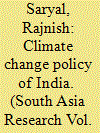

|
|
|
|
|
| Summary/Abstract |
Since the 1970s, and especially following the 1992 Rio Earth Summit, climate change has become an area of high politics, engaging the whole world at the international and diplomatic level. What matters, though, is how this translates into tangible policies at national and local levels, and how these different scales interact. Highlighting India’s unique position in international climate negotiations, this article first scrutinises various official statements and documents of the Government of India (GOI) on climate change and puts them into an analytical framework that demonstrates continuities, but also significant recent shifts. Investigating the reasons for such modifying trends and examining their consequences, the article then suggests that partly owing to recent changes in global and (geo)political contexts, but also due to an Indian re-thinking of responsibility for addressing global climate change, there is a significant new development. This seems to augur a South Asian ‘silent revolution’ in green technologies, a prudent, economically and ecologically beneficial step, not only for India but possibly a sustainable global model.
|
|
|
|
|
|
|
|
|
|
|
|
|
|
|
|
| 17 |
ID:
113413


|
|
|
|
|
| Publication |
2012.
|
| Summary/Abstract |
Many international policies encourage a switch from fossil fuels to bioenergy based on the premise that its use would not result in carbon accumulation in the atmosphere. Frequently cited bioenergy goals would at least double the present global human use of plant material, the production of which already requires the dedication of roughly 75% of vegetated lands and more than 70% of water withdrawals. However, burning biomass for energy provision increases the amount of carbon in the air just like burning coal, oil or gas if harvesting the biomass decreases the amount of carbon stored in plants and soils, or reduces carbon sequestration. Neglecting this fact results in an accounting error that could be corrected by considering that only the use of 'additional biomass' - biomass from additional plant growth or biomass that would decompose rapidly if not used for bioenergy - can reduce carbon emissions. Failure to correct this accounting flaw will likely have substantial adverse consequences. The article presents recommendations for correcting greenhouse gas accounts related to bioenergy.
|
|
|
|
|
|
|
|
|
|
|
|
|
|
|
|
| 18 |
ID:
128451


|
|
|
|
|
| Publication |
2014.
|
| Summary/Abstract |
This article assesses the reasons for observed differences in greenhouse gas (GHG) emissions among high-income OECD countries. Nine factors were tested: climate, population pressure (measured as both growth and density), economic output per capita, technological development, industrial structure, energy prices, environmental governance, pollution abatement and control expenditures, and environmental pricing. Based on a series of regression analyses, three factors - energy prices, economic output per capita, and environmental governance - were identified as the most important factors for explaining differences in OECD per capita GHG emissions. Combined, these three factors explain about 81% of the variation observed in OECD per capita GHG emissions. Individually, energy prices explains about 55% of the variation in per capita GHG emissions, while economic output per capita explains about 19%, and environmental governance about 7%. These findings show that behavioural choices based on existing technologies, rather than exogenous factors such as climate, determine differences in GHG emissions and, therefore, policy options to change behaviour such as increasing energy prices and other regulatory changes have the potential to significantly reduce GHG emissions.
|
|
|
|
|
|
|
|
|
|
|
|
|
|
|
|
| 19 |
ID:
092727


|
|
|
|
|
| Publication |
2009.
|
| Summary/Abstract |
Modern portfolio theory is applied to the problem of selecting which vehicle technologies and fuels to use in the next generation of vehicles. Selecting vehicles with the lowest lifetime cost is complicated by the fact that future prices are uncertain, just as selecting securities for an investment portfolio is complicated by the fact that future returns are uncertain. A quadratic program is developed based on modern portfolio theory, with the objective of minimizing the expected lifetime cost of the "vehicle portfolio". Constraints limit greenhouse gas emissions, as well as the variance of the cost. A case study is performed for light-duty passenger vehicles in the United States, drawing emissions and usage data from the US Environmental Protection Agency's MOVES and Department of Energy's GREET models, among other sources. Four vehicle technologies are considered: conventional gasoline, conventional diesel, grid-independent (non-plug-in) gasoline-electric hybrid, and flex fuel using E85. Results indicate that much of the uncertainty surrounding cost stems from fuel price fluctuations, and that fuel efficient vehicles can lower cost variance. Hybrids exhibit the lowest cost variances of the technologies considered, making them an arguably financially conservative choice.
|
|
|
|
|
|
|
|
|
|
|
|
|
|
|
|
| 20 |
ID:
117325
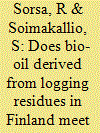

|
|
|
|
|
| Publication |
2013.
|
| Summary/Abstract |
The renewable energy directive (RED) of the EU sets mandatory targets for increasing the use of renewable energy in EU member states by 2020. The RED introduces sustainability criteria for transportation biofuels and other bioliquids in order to ensure that their increasing production does not cause serious environmental and social problems. Bio-oil production through fast pyrolysis is one technology under development. The aim of this paper is to explore whether bio-oil derived from logging residues in Finland meets the GHG performance criteria set by the EU. The pyrolysis reactor is assumed to be integrated with a combined heat and power production plant (CHP). Special attention is paid to uncertainty analysis. An emission reduction target of 60% as compared to the reference fuel is exceeded if the pyrolysis reactor and the CHP plant are considered as separate units, and changes in soil carbon balances are ignored. On the contrary, the particular target is not met using a 20-year time frame for changes in soil carbon balances. The results depend in large measure on the selection of parameters set and the interpretation of the definitions provided in the RED to set the system boundary for the pyrolysis reactor and the CHP plant.
|
|
|
|
|
|
|
|
|
|
|
|
|
|
|
|
|
|
|
|
|